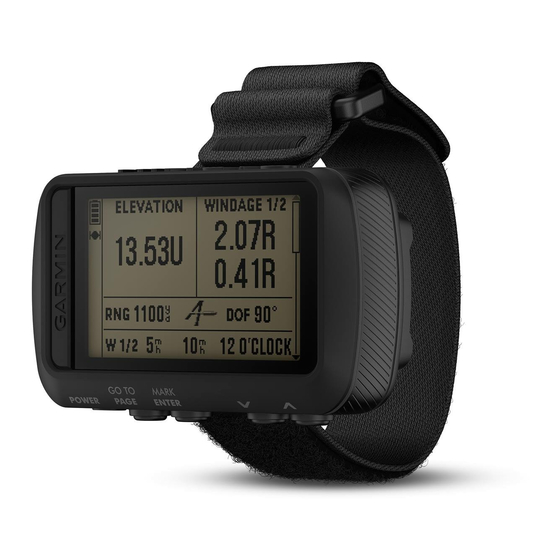Garmin FORETREX 701 BALLISTIC EDITION Руководство пользователя - Страница 29
Просмотреть онлайн или скачать pdf Руководство пользователя для Смотреть Garmin FORETREX 701 BALLISTIC EDITION. Garmin FORETREX 701 BALLISTIC EDITION 30 страниц. Ballistic edition
Также для Garmin FORETREX 701 BALLISTIC EDITION: Руководство пользователя (18 страниц)

OUTPUT UNITS: The output units of measure. A milliradian (mil) is 3.438 inches at 100 yards. A minute of angle
(MOA) is 1.047 inches at 100 yards.
SIGHT HEIGHT: The distance from the center axis of the rifle barrel to the center axis of the scope. Input field.
TIP: You can easily determine this value by measuring from the top of the bolt to the center of the windage
turret, and adding half of the diameter of the bolt.
TWIST RATE: The distance it takes for the rifling of your barrel to make one full rotation. Rifle twist is often
provided by the gun or barrel manufacturer. Input field.
VERTICAL SIGHT SCALE FACTOR: A linear multiplier that accounts for vertical scaling. Not all rifle scopes track
perfectly, so the ballistics solution requires a correction to scale according to a particular rifle scope. For
example, if a turret is moved 10 mil but the impact is 9 mil, the sight scale is 0.9. Input field.
ZERO HEIGHT: An optional modification to impact elevation at zero range. This is often used when adding a
suppressor or using a subsonic load. For example, if you add a suppressor and your bullet impacts the target
1 inch higher than expected, your ZERO HEIGHT is 1 inch. You must set this to zero when you remove the
suppressor. Input field.
ZERO OFFSET: An optional modification to impact windage at zero range. This is often used when adding a
suppressor or using a subsonic load. For example, if you add a suppressor and your bullet impacts the target
1 inch to the left of the expected impact, your ZERO OFFSET is -1 inch. You must set this to zero when you
remove the suppressor. Input field.
ZERO RANGE: The range at which the rifle was zeroed. Input field.
Profile Fields, Gun Properties, Calibrate Muzzle Velocity
ENTER RANGE: The distance from the muzzle to the target. Input field.
TIP: You should enter a value as close as possible to the range suggested in the shooting solution. This is the
range where the bullet slows to Mach 1.2 and begins to enter the transonic range.
ENTER TRUE DROP: The actual distance the bullet falls while in flight to the target, displayed in milliradians (mil)
or minute of angle (MOA). Input field.
Profile Fields, Gun Properties, Calibrate Drop Scale Factor
ENTER RANGE: The range from which you are shooting. Input field.
TIP: This range should be within 90% of the recommended range suggested in the shooting solution. Values
that are less than 80% of the recommended range will not provide a valid adjustment.
ENTER TRUE DROP: The actual distance the bullet falls when fired at a specific range, displayed in milliradians
(mil) or minute of angle (MOA). Input field.
Appendix
25
